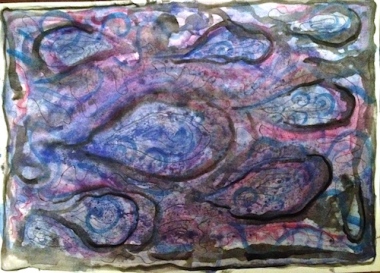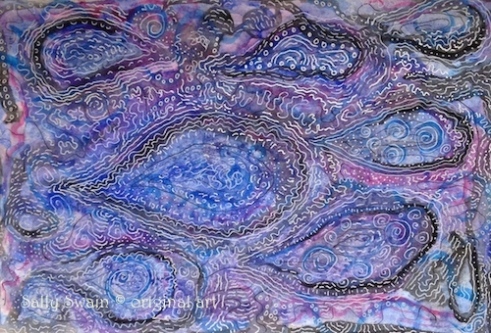the Queen of Blobbage (pronounced in the French way).
Lateral Grieving.

Lateral Grieving
for the Queen of Blobbage
Sally Swain © original art
Who’s heard of it?
Not you. Not me before now, because
I made it up.
Or rather, my art process made it up.
Some months back, I was sad about the death of an aged care resident. She was a dear lady in her early 90s.
Let’s call her Edith.
I’m grateful I was able to facilitate the gentle growth of her artistic confidence. Edith hesitated to begin, but once she engaged with art-making, she smiled and joked. Painting would spark her to reminisce about ohh … boarding school meals, or her grandmother’s aviary.
Art therapy in residential aged care is intimate work. Death and dying go with the territory. You expect that clients will decline in health and indeed die, but naturally you have feelings about this. Doing your own art-making in turn – Response Art -helps to process such feelings.
I begin painting. Wish-wash, wish-wash.
I notice I’m doing paisley shapes. They are sideways across the page.

Lateral Grieving
play-in-progress 1
Sally Swain © original art
Sideways paisley shapes?
I let them become tears.
In this painting,
it seems,

Lateral Grieving
play-in-progress 2
Sally Swain © original art
I am crying sideways.
Why sideways? I wonder.

Lateral Grieving
play-in-progress 3
Sally Swain © original art
Nowadays, there are as many types of grief as there are flavours of potato crisp. This is A Good Thing, unless the labels become constricting. There’s complicated grief, anticipatory grief and disenfranchised grief. There’s ambiguous loss when, for example, your partner with dementia is both present and absent at the same time. Verrrry painful.
My painting speaks to me of Lateral Grieving.
This is what I imagine it means: You are sad. You are not a family member or an old friend. You are several steps removed, yet you’ve been working up close and personal.
Where is the place for your grief?
Who will hold it? Where will it go?
The person is special to you. She entrusted you with her unique individual expression, her stories, her feelings, her creativity. You worked physically closely together. Perhaps you guided her frail hand. You noticed each gesture; each mark she made. You found ways to encourage and support her.
When she continued moving her paintbrush across the page after the paint was long gone, you subtly topped up her paint with the tip of your brush.
When Edith dismissed her painting as a mere blob, you suggested that many wonderful paintings are made up of blobs; that in fact we could claim ‘blobbage’ (pronounced in the French way) as a fine art form. And we could declare her the Queen of Blobbage.
She liked that. She laughed. And continued painting.
After two years of blobbage, Edith declared her favourite colour was yellow. You squeezed yellow paint onto her palette. Edith’s visual impairment meant she couldn’t actually see the yellow she was using.
Lateral grieving.
Where is the place for your grief?
Who will hold it? Where will it go?
Let me attempt to answer my own questions.
Response Art.
Doing your own art-making while lightly holding a sense of the person is one way to tend to your grief.
One placeit can go
and flowout into watery colour.
It’s a release and a knowing,
a blurt and a growing.

Lateral Grieving
for the Queen of Blobbage
Sally Swain © original art
Here’s a poem that wrote itself on the back of my picture.
What’s the weather?
Let’s look at the isobars
Fifty fallen tears
Sixty sideways tears
Tears that squeeze out
Tears that slip slop drop
Tears that fly from here to heaven
in spaceships of scribble
Tears that mark the end,
the beginning,
the continuation.
Why do they say the mystery of death is sweet?
Do they?
Footnote 1
Professional supervision is a place for your grief to go. Even better, I reckon, professional supervision which includes art-making.
Footnote 2
Thank you, Janey Kelf, for art therapy assistance.
Footnote 3
Resources:
A Google search revealed websites that specifically address the grief of healthcare professionals
The Hidden Grief of the Helping Professional
Grief and Loss for Professional Caregivers

Beautiful. I love it.
LikeLiked by 1 person
Thank you kindly, Frenchapple
LikeLiked by 1 person
Course I went into lateral grief and drew and inked some tears sideways and cried thanx xJ
LikeLiked by 1 person
Of course you did!
LikeLike
Thank you so much for your fine, caring work, Ms Transformation
LikeLike
Hi Sally i can truly madly & deeply relate to the sad sadder saddening part of our work. And thank you it’s good to be reminded about the grief we carry every day day for the living loss, that is dementia. I sometimes struggle and need to remember your wisdom of making an art response to all of this. ..x
LikeLiked by 1 person
Thank you, dear Kerry. I can feel your empathy and your fine, strong heart. Art therapy in aged care is definitely challenging (as well as rewarding) work.
Very glad to be of service in reminding you to make art responses.
And hey – I like the way you express yourself in words here.
LikeLike